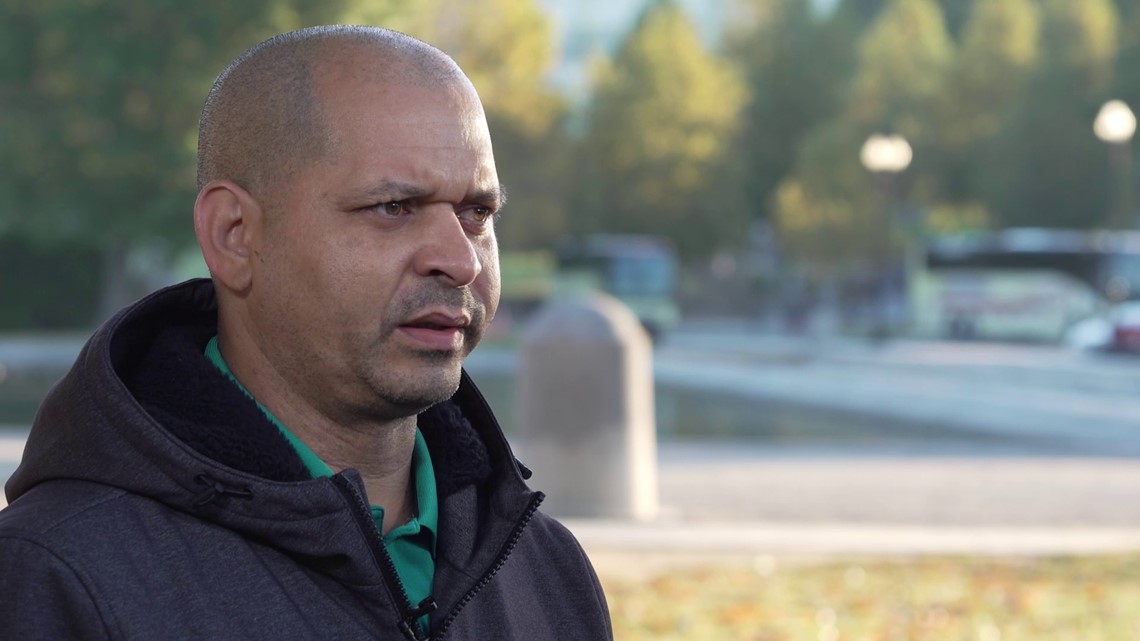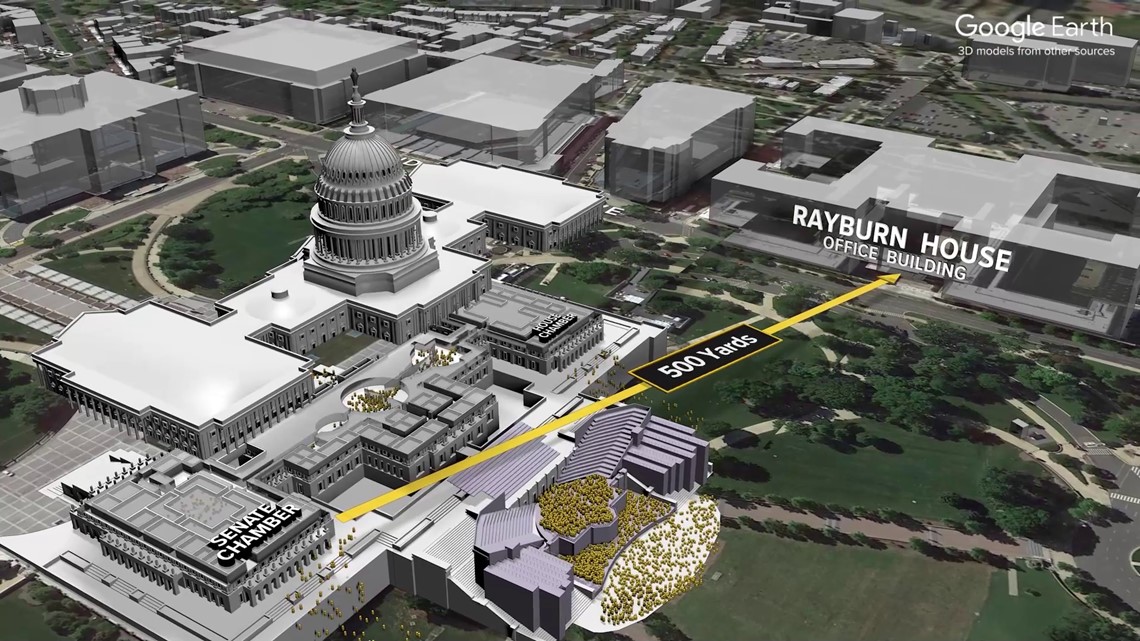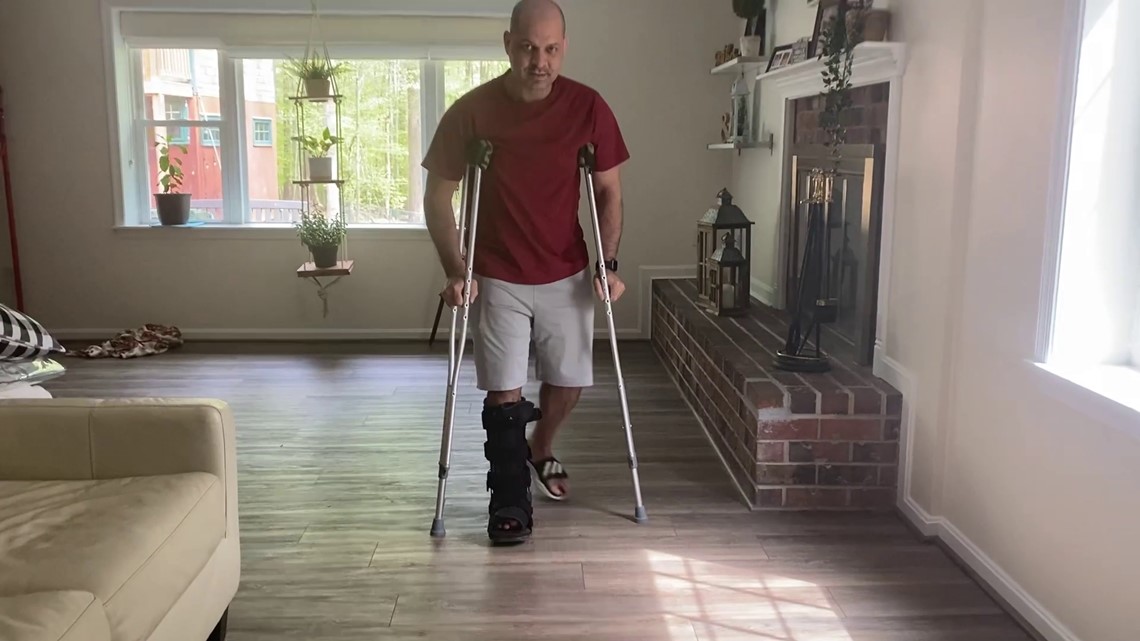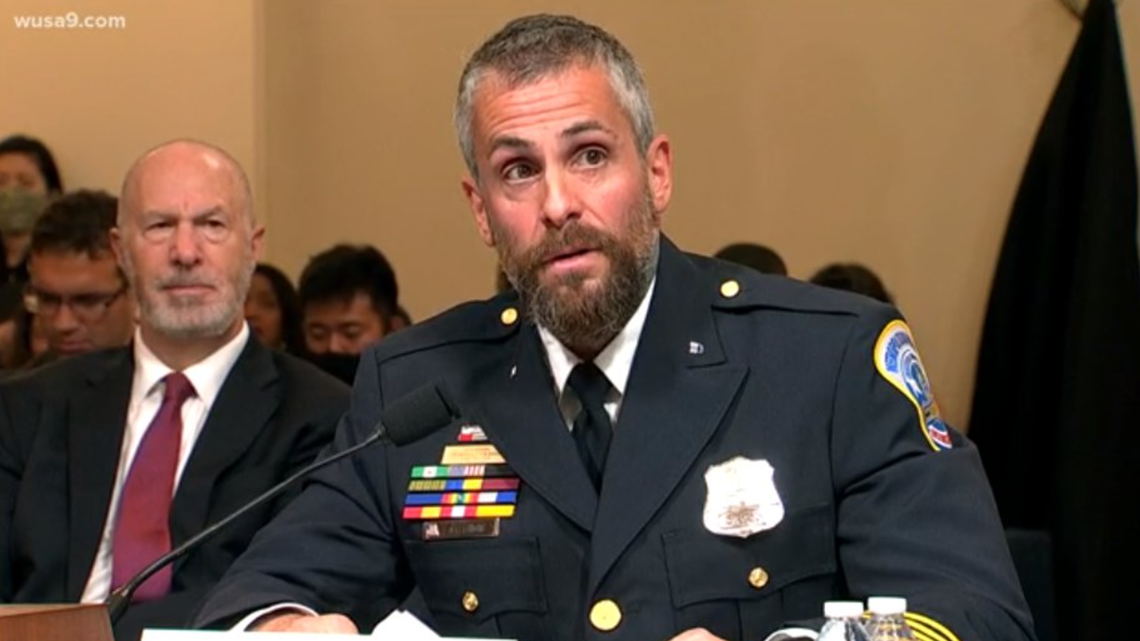WATCH NOW: Democracy Divided: Stories of the Capitol riot
Through new footage and never-before-seen interviews with those who were there, WUSA9 looks back at the January 6, 2021, assault on the U.S. Capitol.

Before Sharon Nichols headed into the U.S. Capitol on January 6, she received a text message asking if she was worried. The president had called tens of thousands of people to D.C. for a rally promoting unfounded claims of election fraud. He’d promised it would be “wild.”
“And I said, ‘No,’” Nichols remembers. “I thought that coming into the Capitol would be the safest place.”
Nichols, like other Hill staffers, was mostly working from home. But she needed to come in that day to get her first dose of the COVID-19 vaccine. On her way to the vaccine clinic at the Rayburn House Office Building, Nichols could tell something was wrong.
“I could hear Capitol Police officers kind of in distress, yelling at each other back and forth,” she said. “I’m sure it was, you know, send help over here or there. This crowd is big, or we need backup at that location.”
WATCH NOW | DEMOCRACY DIVIDED: Stories of the Capitol Riot


When she got to Rayburn, an officer told her she should probably go home. But it was her first opportunity to get the COVID-19 vaccine after a year of hell wrought by the pandemic.
“We’d come off a year of this pandemic that had killed hundreds of thousands of people already, and there was finally light at the end of the tunnel,” Nichols said. She decided to get her first dose.
Before she could leave the clinic, however, the U.S. Capitol Police Department sent out its first alert locking down all Capitol office buildings – including the one where Nichols was getting her shot. No one would be allowed in or out.
“They sent me back to my office and said, yeah, we probably aren’t going to be able to leave this place for a while,” Nichols remembered.
A Tinderbox Waiting for Flame Lies about the 2020 election spark a fire at the U.S. Capitol.
At a TGIFriday’s restaurant nearby, three men who’d met on Facebook were fueling up for then-President Donald Trump’s “Stop the Steal” rally at the Ellipse. It was the culmination of months of lies spread by the president and his allies to cast doubt on the 2020 election, which he’d lost to Joe Biden by more than 7 million votes.
The men – Ronny Sandlin, Nathan DeGrave and Josiah Colt – had connected over their support for Trump. They’d met up in Tennessee and driven to D.C. together to attend the rally.
Sandlin, who organized the trip, according to federal prosecutors, had once built a successful internet marketing company and even started a non-profit organization in L.A. called “The Pedal Movement” to make bicycles accessible to the less fortunate.
But, Sandlin had lost his business, and his way, during the COVID-19 pandemic. According to court documents and family members, Sandlin had fallen into a depression over the past year and had turned his focus to the presidential election and calls to reverse Trump’s loss.
Over a bite to eat and a beer, Sandlin explained in a video posted to social media why he’d come to D.C. on January 6.
“Because I’m so sick and tired of people saying they believe in something and they don’t stand up and fight for what they believe in,” Sandlin said. “I mean, no, but really, like I fight for what I believe in.”
“Freedom is paid for in blood, and tyranny always masquerades itself with safety and security,” Sandlin concluded. “Peace and love. Thanks, guys.”
A short time later, he, DeGrave and Colt headed to the Capitol. Meanwhile, U.S. Capitol Police Sgt. Aquilino Gonell was bracing for a fight.
Gonell is originally from the Dominican Republic. He came to the U.S. when he was 12 years old, and became an American citizen while serving in the U.S. Army.
“My time in Iraq doesn’t compare to everything that happened here on January 6,” Gonell said.


Gonell was one of four U.S. Capitol and D.C. Metropolitan police officers who testified before the House Select Committee to Investigate January 6th. In his testimony, and in interviews after, he said the situation at the Capitol really began to get out of control around 2 p.m. – an hour after then-Vice President Mike Pence released a letter saying he could not unliterally interfere with the electoral vote count, and roughly 50 minutes after Trump ended his speech by urging his followers to march to the Capitol.
“We ran fully equipped with all the civil disturbance unit gear on to help the officers who were already fighting the mob,” Gonell said. “There was no time to devise anything because we were just trying to help out the officers who were getting beat up already. Then we began to get beaten up ourselves.”
Officers from the D.C. Police Department eventually voluntarily deployed to the Capitol to assist beleaguered USCP officers. Bodycam video released from Capitol riot cases shows those officers forcing their way through crowds as angry rioters assault them and yell, “Traitors!”
They arrived to find their brothers and sisters in uniform already under assault.
“I got hit with wood. Poles. Flagpoles. I got sprayed with so many things. People were throwing anything they could get their hands on,” Gonell said. “The metal barriers, they were ripping them apart to take those pieces and use them as projectiles.”
‘I’m Gonna Die Defending the Capitol’ Besieged Capitol Police put their bodies on the line to defend the Citadel of Democracy
In no time at all, the situation at the Capitol had become critical. Hundreds of rioters entered the building – many through a window shattered by Proud Boy Dominic Pezzola – and began making their way toward the Senate Chamber, where lawmakers had a short time earlier been meeting to certify the election.
Among the first rioters to enter the building was Doug Jensen. Jensen, a self-proclaimed “digital soldier” of the QAnon conspiracy theory, was at the front of the mob that chased USCP Officer Eugene Goodman through the Capitol.
Goodman had moments earlier diverted Senator Mitt Romney (R-UT) from heading down a hallway that would have led him into direct contact with Jensen and other rioters. He then took it upon himself to challenge the mob alone and lead them away from the area where members of Congress were hunkered down.
Video of the pursuit shows dozens of people chasing Goodman as they yell, “Keep running mother******!” and “He’s one person, we’re thousands!”
Some 500 yards away, Sharon Nichols had made it to her office in Rayburn.
“The hard part for me was that the rest of my office was teleworking that day,” she said. “So, I was alone in my office. I called my mom and my sister and said, ‘Listen, turn on the news just so you know you know what’s happening. But I’m okay. I’m locked inside.”


Nichols said she turned the lights out in her office and tried to find a balance between having the TV on loud enough that she could hear what was going on but not so loud that anyone could hear it from the outside.
“I didn’t want to draw attention to the fact that somebody was in there,” she said. “If I muted the TV I could hear people walking. I was never sure if they were police officers or other staff or the mob.”
Back in the Capitol, a battalion of USCP and MPD officers was regrouping in the bowels of the building for a final stand. They were led by D.C. Police Commander Ramey Kyle.
In body-worn camera video released by the Justice Department, Kyle can be heard rallying officers before they prepare to face off against thousands of pro-Trump rioters.
“We are not losing the U.S. Capitol today. Do you hear me!” Kyle yells. “We are not losing the U.S. Capitol.”
At the front of the line of officers trying to hold the Lower West Terrace was Sgt. Aquilino Gonell.
“When I started feeling like I was losing air, I came to a conclusion at a point like, OK, this could be my last hour,” Gonell said. “I’m thinking, ‘I’m gonna die defending the Capitol.’ I was prepared for it.”
One of the officers in Kyle’s battalion moved up to take Gonell’s spot face-to-face with rioters. That officer was D.C. Police Officer Mike Fanone. Gonell says he still feels guilty about what happened to Fanone next.
Members of the mob grabbed Fanone and dragged him into the crowd – beating him savagely with metal flagpoles and stolen police batons and tasing him repeatedly. Fanone says he heard them chanting, “Kill him with his own gun!” As a result of the assault he suffered a concussion and lost consciousness, and it was eventually determined he had a mild heart attack. Fanone’s limp body was eventually grabbed and pulled back into the building by his fellow officers.
‘No Looking Back Now, Boys’ Brought to D.C. by President Donald Trump, three men join the assault on the Capitol
‘No Looking Back Now, Boys’
While the war to defend the West Terrace raged on, other rioters – including Ronny Sandlin, Nathan DeGrave and Josiah Colt – found other ways into the Capitol.
In video released by the Justice Department, Colt can be heard urging his friends to push deeper into the building.
“Let’s get to the Senate. The Senate, bro. The Senate. Where they are meeting,” Colt says. “No looking back now, boys.”
According to prosecutors, the three men were among the first rioters to arrive at the Senate door, where they found two lone USCP officers attempting to guard the entrance. In short matter, the door was breached.
“No going back now!” DeGrave can be heard saying, the DOJ says. “You just made history, bro. That’s your seat, bro. That’s your seat!”
Nearby, Colt declares, “This is our house now. It is not China’s house. This is for America. This is for the people. This is for freedom.”


“We need everyone f****** in here now!” DeGrave yells. “Take laptops, take paperwork, take everything!”
By the time the mob reached the Senate, members of Congress had already been evacuated. Meanwhile, on the other side of the Capitol, another life-and-death battle was being waged.
At the door to the Speaker’s Lobby, a small group of officers was trying to hold off dozens of rioters while elected officials were still rushing to safety. In a video captured by John Earl Sullivan, of Utah – now charged himself in the case – rioters can be seen smashing in the window of one of the doors. One rioter, Air Force veteran Ashli Babbitt, then begins to climb through.
Moments later, U.S. Capitol Police Lt. Michael Byrd fires a single shot – striking Babbitt in the shoulder.
In the video, officers can be heard yelling at the crowd to get back while they work to provide Babbitt with medical aid.
“We cannot get enough people to move to get her out of the building!” one officer says. “She’s bleeding out on the floor.”
Babbitt, who had become a fanatic supporter of Trump and the QAnon conspiracy theory, was pronounced dead a short time later at a nearby hospital.
As news spread that a rioter had been shot, those bent on violence seemed emboldened. It was not long afterward that the war at the West Terrace reached a new level.
In body-worn camera video from four different officers who were attacked holding the entrance, bodies can be seen strewn on the ground as a bearded man in a Michigan sweatshirt – now identified as Justin Jersey – charges and attacks officers, trying to rip away their batons.
The small group of officers was brutalized with anything the mob could find, including flagpoles, sticks, and projectiles launched through the air like incoming missiles.
The DOJ says former CrossFit instructor Jack Wade Whitton, of Georgia, can be seen beating police with a crutch and then stomping on an officer while they cried out for help.
The officer, identified in court documents as “A.W.,” was forced to scratch, claw and crawl to save himself.
Then, a Pennsylvania man identified by the DOJ as U.S. Marine Corps veteran Michael Lopatic joins the assault on police. He’s followed by a deputy sheriff from Tennessee named Ronald McAbee. McAbee can be seen in a video standing over the lifeless body of another rioter, Rosanne Boyland.
The D.C. Medical Examiner’s Office eventually determined Boyland died of an acute amphetamine overdose. Along with Babbitt, Boyland was one of five people who lost their lives amid the riot. The three others, among them USCP Officer Brian Sicknick, all died from natural causes, according to autopsies.
What History Will Remember 11 months later, the scars of January 6 remain
It was nightfall before police had pushed the remaining rioters back. Sharon Nichols had spent eight frightening hours alone until the lockdown was lifted.
“I knew I was after curfew, so I kept my badge on or displayed so that people could see that I wasn’t causing trouble,” she said. ”So the first thing I did was, you know, I tweeted that I got home, I'm safe. I called my family. Going to sleep that night was tough. Because of all the adrenaline of the day, but then also it's sinking in and realizing that it'll have consequences for years that people died that day.
“I cried,” Nichols said. “I cried several times. And then you try to process it. And I’m talking to friends and thinking about the repercussions down the road. How many years would we be talking about this?”
After a 22-hour day, Sgt. Aquilino Gonell made it home himself.
“I was crying like I never cried before,” he said.
When he got home, his wife, Monica, was there waiting for him.
“I put the blanket over myself and gave her a big hug for 20 minutes,” he said. “I couldn’t believe that my fellow citizens attacked us. I couldn’t believe that. They attacked the police. I couldn’t believe that in America this was happening.”
For Gonell and other officers who defended the Capitol on January 6, the mental and physical scars are still healing. But, he says, there are good days too. Like the day he first walked on his own after surgery to remove metal plates and screws in his foot from injuries caused by rioters.
When he took that step, his 10-year-old son Emmanuel was there cheering him every step of the way.
“I told him, people will read about what I did and what the other officers did,” Gonell said. “I told him he should be proud because I did what I had to do to keep the system that we have in place. And when I said that to him, he was like, well, if that ever comes in the history books and I’m studying it, or they bring it up in class, I’m going to say, ‘That’s my dad! That’s my dad and I’m proud of him.’ That felt good.”


After five months behind bars, rioter Doug Jensen was released from pretrial detention. As a condition of his release, Jensen was prohibited from accessing the internet or using internet-connected devices. On the very first home visit, probation officers found him in his garage watching MyPillow CEO Mike Lindell’s “cyber symposium” on election fraud conspiracies. He was sent back to jail, where he remains while he awaits trial on felony charges of obstruction of justice and assaulting police.
Josiah Colt pleaded guilty in July to one felony count of obstruction of an official proceeding. He faces a recommended sentence of five years in prison at sentencing. As part of his plea agreement, Colt agreed to cooperate with the government’s prosecution of other rioters.
Colt’s friends, Ronald Sandlin and Nathan DeGrave, remain behind bars while they await trial on multiple felony charges for assaulting police and obstruction. A federal judge this week denied their request to have the obstruction charge thrown out. They face up to two decades in prison if convicted.
Sharon Nichols has returned to working in the same office where she hid for hours on January 6.
U.S. Capitol Police Sgt. Aquilino Gonell got the opportunity to share his story in person to members of Congress at the inaugural meeting of the January 6th Committee. He was joined by U.S. Capitol Police Officer Harry Dunn and D.C. Police Officers Mike Fanone and Daniel Hodges. Gonell returned to active duty on November 3.


In August, President Joe Biden signed legislation awarding the Congressional Gold Medal to all of the officers who helped defend the U.S. Capitol Building on January 6.
To date, more than 700 people have now been arrested from nearly all 50 states for crimes related to the Capitol riot. That includes more than 220 defendants for assaults on law enforcement. More than 110 defendants charged in the case have pleaded guilty to charges ranging from parading in a Capitol building to assaulting police with a dangerous weapon. The longest sentence handed down to date will have a Florida man, Robert Scott Palmer, serve more than five years behind bars.
We're tracking all of the arrests, charges and investigations into the January 6 assault on the Capitol. Sign up for our Capitol Breach Newsletter here so that you never miss an update.

